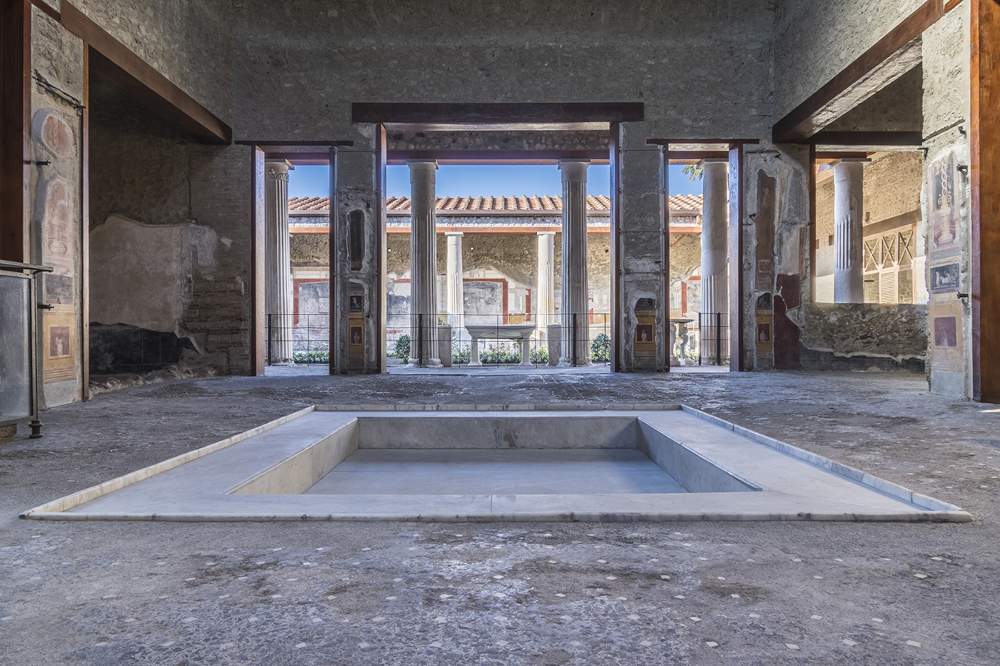This morning, after several postponements, the House of the Vettii in Pompeii Archaeological Park was reopened in the presence of Culture Minister Gennaro Sangiuliano, Culture Ministry Museums General Director Massimo Osanna and Pompeii Archaeological Park General Director Gabriel Zuchtriegel.
“Pompeii is the place where the value of the unicum that is Italian culture is perceived,” Sangiuliano said at the ribbon-cutting ceremony.
A domus has been returned to the public, which for the first time, after 20 years of closure and a partial reopening in 2016 related to the atrium entrance hall and surrounding areas, can be admired in all its articulation and architectural complexity, thanks to recent interventions. The new restoration project, undertaken in 2016 under the direction of Massimo Osanna, has relied on the collaboration of various professionals, including archaeologists, architects, restorers, engineers, structural engineers and gardening experts, constituting one of the most complex worksites in the panorama of archaeological heritage in recent decades. Particularly difficult proved to be the removal of layers of wax, made on the frescoes in the past with the intention of protecting them and making them shine: a restoration method that proved highly damaging and also obscured many details of the refined paintings, with representations of fantastic architecture and mythological scenes.
The peristyle garden (colonnaded garden), which had an intricate system of water pipes and small fountains, was restored with the inclusion of copies of the original statues kept in the exhibition spaces and storage rooms of the Archaeological Park. Prominent among them is a unique statue of Priapus, god of abundance. In addition, ancient plant species reproduced in the nursery inside the Park have been planted as part of a larger project to enhance historic gardens and put the green areas of the ancient city into production through partnerships with local farmers and producers.
Excavated between 1894 and 1896, the house of the Vettii belonged to Aulus Vettius Conviva and Aulus Vettius Restitutus, probably two freedmen who became rich through the wine trade. The opulent pictorial and sculptural decoration of the house, therefore, also reflects the wealth of the city’s territory, where wine was produced for export throughout the Mediterranean, and the social mobility, which allowed two former slaves to rise to the highest levels of local society.
There is no shortage of traces of the life of the last, including a room adjacent to the kitchen in the servile quarter, decorated with erotic paintings. The room was once equipped with an iron door to allow access only to adult men, a barrier removed only a few days before the house was reopened. It has been hypothesized that the room was used for prostitution, a hypothesis that seems to be reflected in the discovery, on the left wall of the vestibule, of an inscription in which a woman named Eutychis, “Greek and of fine manners,” was offered for two aces (Eutychis Graeca a(ssibus) II moribus bellis).
“The reopening of the House of the Vettii,” declares Minister of Culture Gennaro Sangiuliano, "is the crowning achievement of a multi-year journey of full recovery of the Pompeii excavations. From today the public will be able to return to admire a unique environment that has been inaccessible for 20 years. I thank the staff of the archaeological park for making this authentic gift to the world possible."
“It is a momentous reopening that marks the end of a long and troubled history of restoration, which in recent years has made use of the successful model of the Great European Project, both in the management of funding and human resources, but with the difference that in this case everything has been managed, from planning to interventions, with the internal forces of the Park,” says the Director General of the Museums, Massimo Osanna. “A fundamental step that seals the autonomy and success of the ordinary management of Pompeii, now an internationally recognized example.”
"The House of the Vettii is the history of the Roman world enclosed in a house, the ’house museum’ of Romanity so to speak: there we find mythological frescoes and sculptures in bronze and marble, of exceptional artistic quality, that speak of the complex relationship between Greek models and Roman reworkings, but also the economic and social life of the city. The owners, freedmen and therefore former slaves, are an expression of a social mobility that would have been unthinkable two centuries earlier. They became rich by trading in agricultural products from the area around Pompeii, but apparently prostitution was also practiced in their house, by a Greek slave, who belonged to the weaker groups of society," points out Gabriel Zuchtriegel, Director of the Pompeii Archaeological Park
Pictured is the atrium of the House of the Vettii. Photo by Silvia Vacca.
 |
| Pompeii Archaeological Park's House of the Vettii reopened today after several postponements |
Warning: the translation into English of the original Italian article was created using automatic tools. We undertake to review all articles, but we do not guarantee the total absence of inaccuracies in the translation due to the program. You can find the original by clicking on the ITA button. If you find any mistake,please contact us.